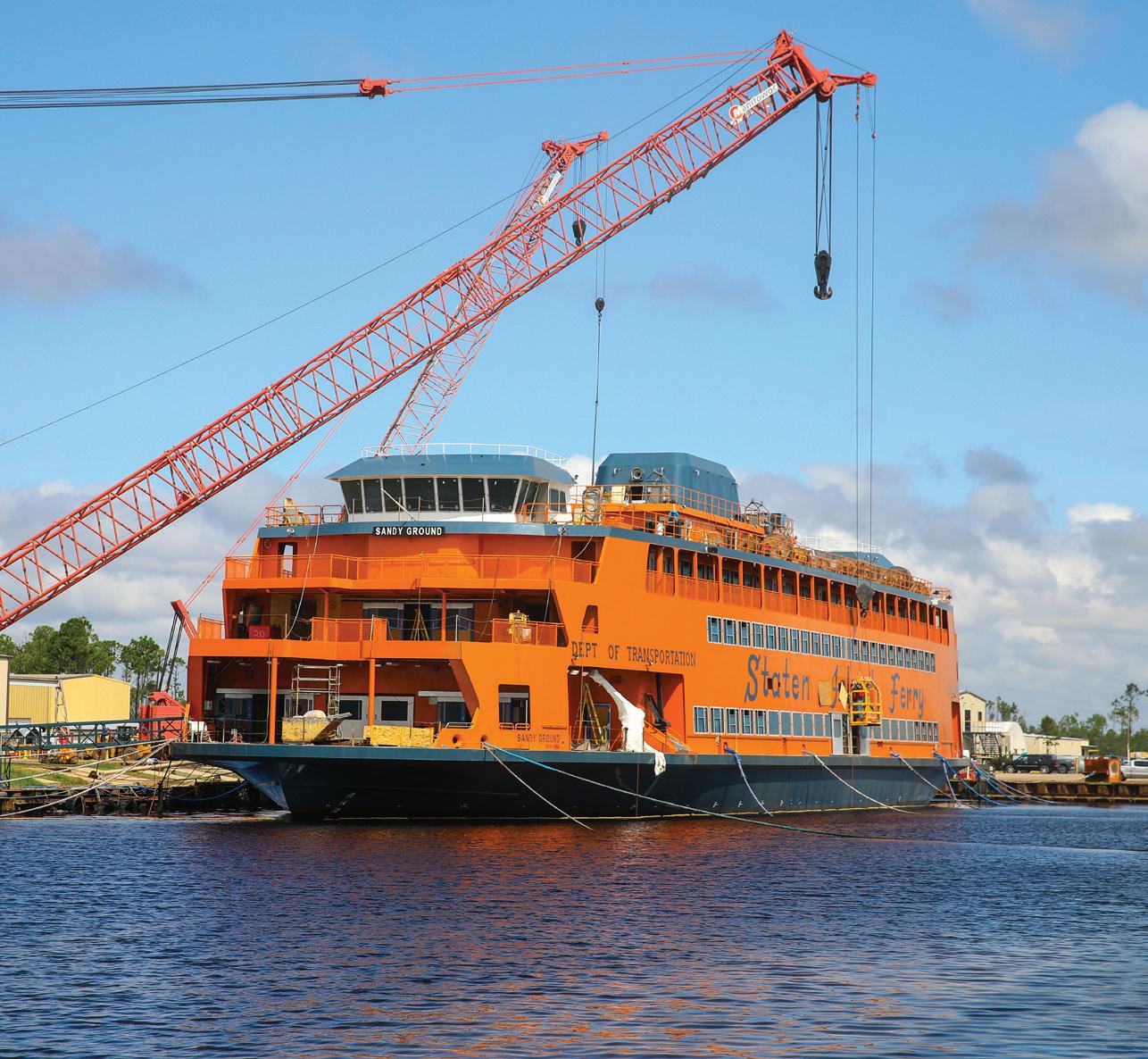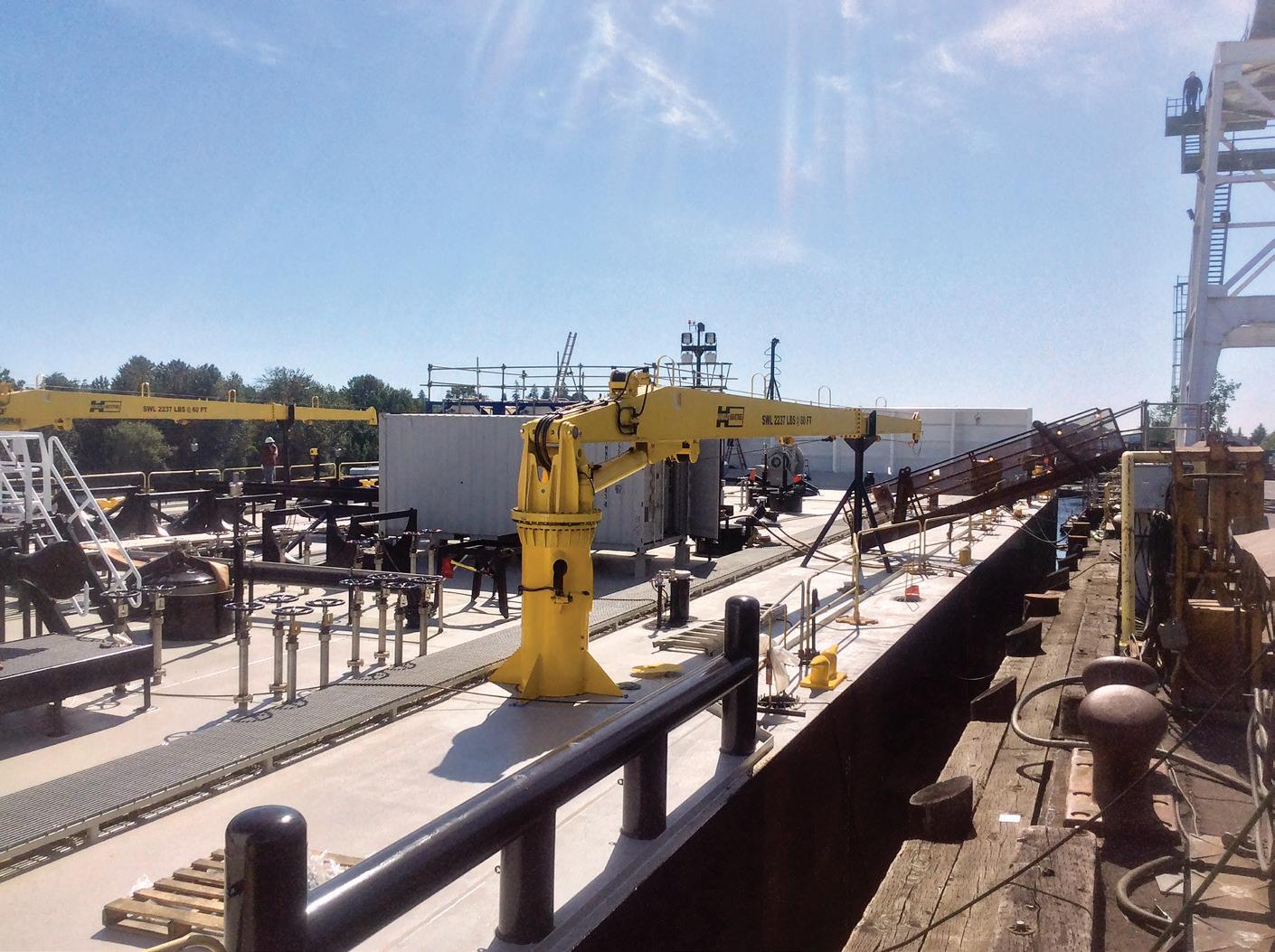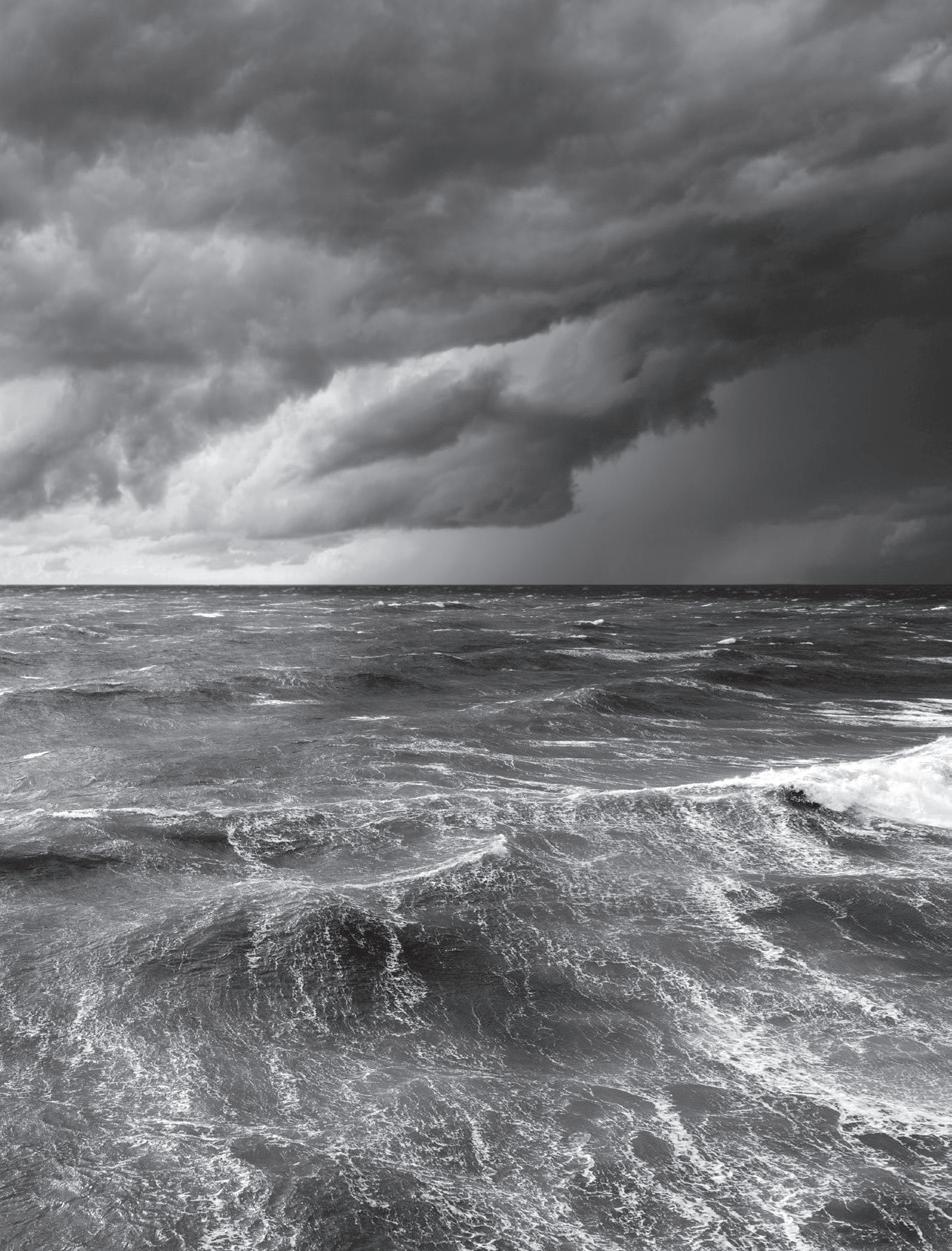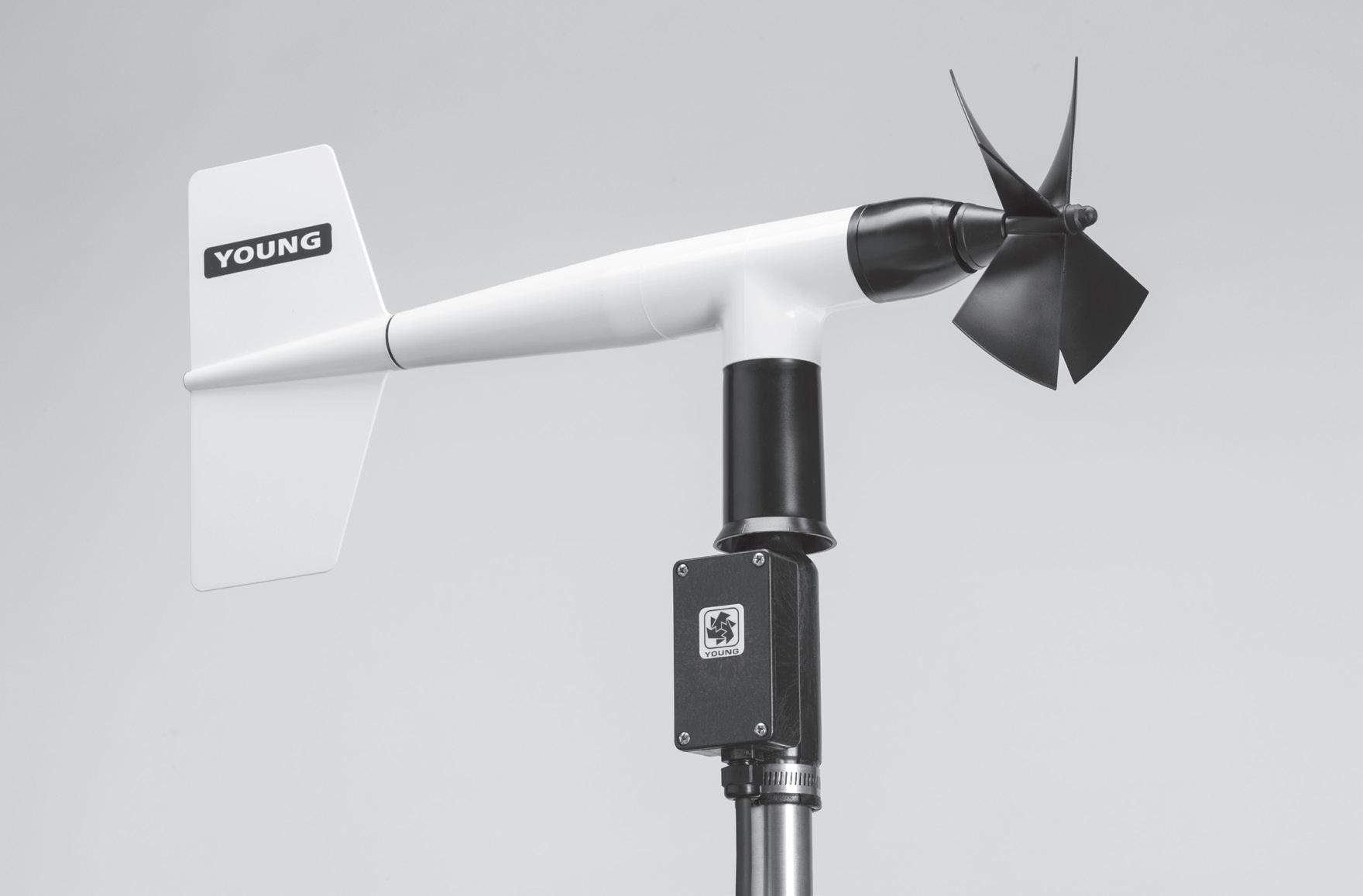
20 minute read
Mail Bag
by WorkBoat
Disputes greenhouse gas emissions statement
In the December 2020 issue of WorkBoat, No. 4 of the Top Ten Stories of 2020, “Hurricane Season Batters Gulf,” contains the sentence, “The combination of warmer ocean waters — caused by absorption of excess heat created by greenhouse gas emissions — and seasonal weather patterns help fuel the storms.”
While it is almost certainly true (because nothing is 100% certain in science) that warm ocean waters fuel hurricanes, and it thus follows that warmer waters fuel more, and more intense, hurricanes, the assertion that warmer ocean waters are caused by “greenhouse gas emissions” is, at best, highly controversial. At worst, it is an outright fabrication weakly supported primarily by computer models of highly dubious accuracy, one of the goals of which is to eliminate the fossil fuel industry upon which much of the workboat industry is based.
This line of thought, and the associated evidence for and against, could easily be developed into a book, if not an entire encyclopedia, dedicated to the closely related topics of climate change and political power.
Suf ce it to say here that highly controversial statements that can only serve to undermine an industry important to the workboat community should not be misrepresented as fact by a publication that exists to support that community.
Rick Lutowski
Naval Architect Georgetown, Texas
Reader enjoys columnist’s remarks
Once again Capt. Alan Bernstein hit the nail on the head in his remarks about Congress negotiating as small businesses suffer or die (“2020: Good riddance,” Captain’s Table, WorkBoat, December 2020).
His column is still the rst article I read when I get WorkBoat magazine each month. Keep up the great work and good luck!
Capt. R.M. Silva Toms River, N.J.
WorkBoat encourages readers to write us about anything that appears in the magazine, on WorkBoat.com or pertains to the marine industry. To be published, letters must include the writer’s address and a daytime phone number. Email your letter to:
workboat@cox.net
We take the heat, so you don’t have to.
Cool. Because you need it. We deliver cool based on your reality. So no matter where you operate, hot days and heavy loads will never slow you down.

GRIDCOOLER® Keel Cooler
• One Piece Head Design maintains greater structural integrity. • Higher Silver Content Braze Joints resist fatigue and maintain the strength of surrounding material. • Better Penetration at Braze Joints places more braze material with less heat, making joints stronger.

WEKA Boxcooler®
• Over 20 Years of Experience with
Copper Nickel Boxcoolers offering longer product life cycle than standard coated tube units. • Manufactured in the USA and
The Netherlands: provides the greatest product availability. • Weka Guard and Protector eliminate the need for bulky and costly copper sacrificial anodes.
Tranter® Heat Exchangers
• Tranter Superchanger plate and frame heat exchanger provides a range of options in pattern, size and material for a wide variety of applications. • Tranter Platecoil provides an efficient and cost effective alternative to traditional pipe coil heating for bulk cargo, ballast and other applications.
© 2021 R.W. Fernstrum & Company. All rights reserved. FERNSTRUM® and GRIDCOOLER® are registered trademarks of R.W. Fernstrum & Company. All other trademarks cited are the property of their respective owners.

Building the Next Generation



Nelson Street Facility 2200 Nelson Street Panama City, FL 32401 Allanton Facility 13300 Allanton Road Panama City, FL 32404 sales@easternshipbuilding.com 850-763-1900
On the Water
Avoid deck skating — Part I
By Joel Milton
It’s that special time of year again in the Northern Hemisphere where mariners can enjoy the thrills and spills of walking on snowy and icy decks.
The falls that can result from slick decks can be more than just embarrassing. They can cause signi cant to serious injuries, and possibly cause you to go over the side.
Typically, the admonition from shoreside safety managers is to shovel the snow overboard, break up any ice, remove it, and salt or sand the surfaces. This is sensible enough but is much easier said than done. Depending on the amount of snow or ice accumulation, shoveling and ice removal can be extremely labor intensive and time consuming. Minimal manning standards help make this chore a big challenge, if not an impossibility, particularly during long bouts of bad winter weather. It affects everything you do on deck and can easily get way ahead of you to the point where a complete manual removal of the snow and ice is just not realistic. You may need a thaw to assist you, and meanwhile the slip-andfall risks remain.
Preventing the possibility of a slip or fall altogether, particularly while engaged in snow or ice removal activities, is often overlooked. But there are easy, inexpensive ways to address it by using ice and snow cleats worn over your boots.
Carbide cleats have been around in many forms for a long time. While effective, they’re generally a pain to put on, cause deck damage, and can cause sparks that make them unsuitable to use on tank barges.
Depending on the conditions, look instead to Kahtoola MICROspikes or Yaktrax Pro for traction to keep you upright. Each are excellent but perform best in different circumstances. For light snow or icing the Yaktrax Pro shines and does reasonably well in more challenging conditions. But when the ice is really heavy, and your labors are too, nothing beats the mountain goat-like traction of MICROspikes. Having both is best, and they’re much cheaper than a lost-time injury.
Joel Milton works on towing vessels. He can be reached at joelmilton@yahoo.com.
Captain’s Table
Getting past Covid: A cry for normality
By Capt. Alan Bernstein
If there was ever a need for face-to-face meetings, now is the time. Unfortunately, it is still too early given the lingering effects of the coronavirus pandemic and the potential health risks associated with it.
During the Covid-19 pandemic I have missed attending maritime industry events with friends in the industry. The knowledge, the lessons learned and the camaraderie at these meetings is always uplifting. We all have lost business this past year, but can we put a price on what we have lost in terms of the meaningful things that we learn from our peers?
Events that provided guidance, information, and contacts such as the International WorkBoat Show, the Great Lakes Waterways Conference and others were all shelved in 2020. The loss is huge. Virtual events and conferences are a temporary alternative to in-person events until we can safely get back together again.
For nearly a year now, my daughter Terry and I have been hosting a regular virtual happy hour conference call that includes many of our friends in the passenger vessel industry. At times, we have had up to 25 individuals on our calls. We have discussed Covid and how we are all coping. We have talked about business — mostly the lack of business — analyzed nancial strategies to survive, and have discussed the need for emergency funding from the government. Some of us even discussed shutting down completely, given that most of our businesses were off by as much as 90%. Some took this action, while others decided to continue operating with skeleton crews and schedules.
The Passenger Vessel Association (PVA) also participated in our calls to provide updates on its ongoing work in Washington, D.C., to garner relief for the industry.
These virtual calls have been a godsend, but have not replaced face-to-face meetings.
PVA has decided to hold a virtual convention this year to ensure that its members have an opportunity to gather, if only remotely. The 2021 PVA Virtual Convention is scheduled for Feb. 16-18.
Virtual meetings will never replace face-to-face meetings, but they are a good way for us to carry on, stay in touch and continue to learn from each other. I look forward to the day when things return to normal and we can once again shake hands safely and gather together.
Alan Bernstein, owner of BB Riverboats in Cincinnati, is a licensed master and a former president of the Passenger Vessel Association. He can be reached at 859-292-2449 or abernstein@bbriverboats.com.
Energy Level
European majors are top bidders at Gulf lease sale

By Jim Redden, Correspondent
Though most European oil majors sound like they want to be de ned as anything but, that didn’t stop them from being the most proli c bidders in the latest Gulf of Mexico lease sale.
Some of the continent’s largest multinational players are devaluing what was once their core reason for being in favor of increased investments in wind, solar, biofuels and similar renewable energy sources. Most have committed to complying with the European Union (EU) directive to be “climate-neutral” by 2050, which is in line with the 2016 Paris Agreement.
However, the U.S. operating arms of three of Europe’s largest majors were the top bidders for the mostly deepwater blocks offered in the Nov. 18 federal lease offering, according to a post-sale ranking by the Bureau of Ocean Energy Management (BOEM). The Netherlands-based Shell led all of the 23 operators participating with just under $28 million in high bids, followed in order by Norway’s Equinor at about $22 million and the UK’s BP at more than $17 million.
Ranked seventh at a little more than $6.4 million in high bids was Spain’s Repsol, which in December 2019 became the rst to commit to net zero emissions, and at the same time wrote down the pre-Covid value of its oil and gas assets by $5.7 billion. As of November, Repsol had spent more than $367 million in 2020 to develop clean energy projects, compared to $232 million for traditional oil and gas projects, according to Bloomberg. The company’s 2021-2025 strategic plan calls for no less than 30% of annual expenditures to be directed to its lowcarbon business.
Repsol has no plans to furlough all its rigs anytime soon, but the ones remaining will not mobilize to frontier prospects and will be concentrated only in known and developed areas, said CEO Josu Jon Imaz. “We are going to go on exploring. I mean exploration is going to be part of the future of Repsol. But we are changing our mindset about exploration because the world is changing,” he said in a Nov. 1 earnings call.
Meanwhile, U.S. super major Chevron was the fourth highest bidder at more than $17 million and a few weeks later said it would cut yearly capital spending by 26% as Covidrelated demand destruction forces companies to reassess their petroleum assets. Chevron will spend $14 billion this year and no more than $16 billion a year through 2025, with $300 million directed to projects related to the transition to a “lower-carbon energy future.”
A non-participant in the sale, ExxonMobil, likewise, put the eraser to its capital budgets with yearly spending to be slashed by $5 billion to $10 billion through 2025.

OCT. '20 NOV. '20 DEC. '20 DEC. '19 WTI Crude Oil 38.39 42.91 47.50 61.66 Baker Hughes Rig Count 13 13 17 23 IHS OSV Utilization 20.7% 20.6% 21.2% 29.6% U.S. Oil Production (millions bpd) 10.5 11.1* 11.0* 12.9WTI Price U.S. Prod 1000s bopd GOM Rig CountUtil. Rate %
Sources: Baker-Hughes; IHS Markit; U.S. EIA *Weekly Estimated
25
20
15
10
5
0 GOM RIG COUNTGOM Rig Count
12/19 12/20
1 2 3 4 5 6 7 8 9 10 11 12 13
Dec-19 23 Jan-20 21 20-Feb 22 Mar-20 18 Apr-20 17 May-20 12 Jun-20 20-Jul 11 12 Design. Build. Marine Cranes. Aug-20 13 Sep-20 14 20-Oct 13 Nov-20 13 Dec-20 17 Canada USA
Chester, NS Everett, WA T: 1-902-275-3591 T: 1-206-595-5529
E: sales@hawboldt.ca E: reed.okawa@hawboldt.ca
www.hawboldt.ca

WorkBoat Composite Index
Stocks gained 7% in 2020
WorkBoat stocks closed 2020 on an up note, gaining 70 points in December, or just over 3%. Winners topped losers 19-8. For the year, the WorkBoat Composite Index gained 156 points, or about 7%. In 2019, the Index gained 21%.
Seacor Holdings Inc. jumped 25% in December. On Dec. 7, the company announced that it had entered into an agreement with American Industrial Partners to take the company private. The transaction is valued at approximately $1 billion, including debt.
Under the terms of the deal, AIP will acquire all outstanding shares of Seacor for $41.50 per share in cash. The share price represents a premium of approximately 14% to the company’s closing stock price on Dec. 4, 2020, the last trading day prior to the Dec. 7 announcement, and a premium of approximately 31% over the 90-day weighted average price. The transaction is expected to close by the end of the first quarter of 2021.
Seacor Marine Holdings rose 32% in December. The company announced on Dec. 18 that it would sell Windcat Workboat Holdings Ltd. and its crew transfer vessel business to Compagnie Maritime Belge (CMB) for $44.6 million in cash (£32.8 million) and also assume $27.8 million (£20.4 million) of debt. The transaction was expected to close by Jan. 12, 2021. Windcat is a leading offshore wind support vessel provider in Europe and owns and operates a fleet of 46 CTVs in the European offshore wind sector. — David Krapf
STOCK CHART Source: FinancialContent Inc. www. nancialcontent.com
INDEX NET PERCENT COMPARISONS 10/30/20 12/31/20 CHANGE CHANGE Operators 286.43 298.59 12.17 4.25% Suppliers 4,161.09 4,292.11 131.02 3.15% Shipyards 2,773.52 2,804.07 30.55 1.10% Workboat Composite 2,269.79 2,340.30 70.51 3.11% PHLX Oil Service Index 39.31 44.33 5.02 12.77% Dow Jones Industrials 29,638.64 30,606.48 967.84 3.27% Standard & Poors 500 3,621.63 3,756.07 134.44 3.71% For the complete up-to-date WorkBoat Stock Index, go to: www.workboat.com/resources/workboat-composite-index
Inland Insider
Jones Act gets another boost
By Pamela Glass, Washington Correpondent
Congress has approved signi cant measures to strengthen the Jones Act.
Included in the National Defense Authorization Act (NDAA) is a landmark provision that would apply U.S. laws, including the Jones Act, to the offshore wind industry. Until now, there had been signi cant confusion on the issue created by con icting federal agency interpretations.
The Jones Act requires that cargo moved between two U.S. “points” or ports be carried by vessels that are built and agged in the U.S., crewed by U.S. mariners and owned largely by U.S. citizens. The maritime industry considers the Jones Act as essential to a strong maritime industry and a robust national defense response.
The NDAA would essentially de ne an offshore wind farm located in the Outer Continental Shelf as a U.S. port, which would require that vessels working on these projects be compliant with the U.S. crew and build provisions of the Jones Act. A foreign- ag vessel, for example, couldn’t be used to transport turbine blades from a U.S. port to an offshore wind project. Similar rules already apply to offshore oil and gas activities.
This legislation is a positive development for vessel operators and renewable energy developers because it offers clarity and a level playing eld for all involved in offshore wind. According to the American Waterways Operators, it “paves the way for signi cant new investment in American vessels and jobs for American mariners” in this growing energy sector.
The new law includes other signi cant Jones Act initiatives. The rst clari es the terms and procedures under which a waiver to the Act can be granted. A national defense waiver must be tied to national defense needs, while non-defense waivers will be time limited, and all waivers will be subject to public reporting requirements by a foreign vessel using the waiver to operate in U.S. markets.
The second includes two “Sense of Congress” statements reaf rming strong support for the U.S. maritime industry and the Jones Act.
Also of signi cance, NDAA gives the Maritime Administration authority for the rst time to provide nancial assistance to maritime entities and industries that have been hurt by national emergencies like the Covid-19 pandemic. The industry says NDAA includes the most signi cant maritime legislation enacted by Congress in many years.
Pamela Glass is the Washington, D.C., correspondent for WorkBoat. She reports on the congressional committees and federal agencies that affect the maritime industry, including the Coast Guard , Marad and Army Corps of Engineers.
Nor’easter
Is it time again for offshore wind?
By Kirk Moore, Contributing Editor
The U.S. offshore wind industry appears poised at the brink of optimism it rst saw a decade ago, when Obama administration of cials talked of wind power assuming coal’s then-dominant role in the nation’s electric grid.
That moment was dashed when the Cape Wind proposal off Massachusetts was hounded away by its Cape Cod opponents, and the Obama offshore energy plans derailed by the April 2010 Deepwater Horizon disaster.
Now with the Biden administration looking to renewable energy as a cornerstone of economic recovery, offshore wind’s time could be here again. And just before leaving for the holidays, Congress took a step to push for employing more U.S. mariners in the industry.
The annual National Defense Authorization Act – af rmed by Congress in its rst override of a presidential veto by Donald Trump – included a provision explicitly requiring that all U.S. laws including the Jones Act apply to renewable energy development on the Outer Continental Shelf.
“By eliminating uncertainty over this issue, Congress will help unleash robust investment and job creation in the American maritime industry tied to clean offshore energy development,” the American Maritime Partnership said in celebrating the nal vote on New Year’s Day.
The bipartisan push to ensure wind developers comply with the Jones Act and Outer Continental Shelf Lands Act of 1953 came after months of dueling among lobbyists from wind and offshore services industries.
Wind power advocates warned a looming worldwide shortage of wind turbine installation vessels would hobble development of U.S. projects for years, before Jones Act-compliant WTIVs can be built.
The offshore industry countered that U.S. companies with their experience and expertise can keep the work rolling during that time — without need for Jones Act waivers.
That outcome could be a win for both the U.S. maritime and commercial shing industries.
Contributing Editor Kirk Moore was a reporter for the Asbury Park Press for over 30 years before joining WorkBoat in 2015. He has also been an editor for WorkBoat’s sister publication, National Fisherman, for over 25 years.



Insurance Watch
Do you need cyber coverage?
By Chris Richmond
Arecent policy review found that a client, who distributes seafood, had reduced gross revenues. This was not a surprise given the downturn in the economy. What was surprising was a sharp increase in retail sales from its growing online store. The company was in need of a cyber policy.
There are two important types of cyber liability — rst party and third party. A rst party cyber liability occurs when your own data is stolen. This can include your employees’ personal information or information about your customers. A cyber liability policy will provide credit monitoring services to assist the affected individuals which could help minimize the risk of identity theft.
Included in rst-party cyber liability are: • Funds transfer fraud, an intentional, unauthorized instruction transmitted via email to a nancial institution to transfer funds. If your computer system is compromised, a hacker can get access to your banking information and initiate fraudulent electronic wire transfers. • Lost business income due to cyber theft (a hack or data breach) is not covered unless cyber coverage is in place. Your regular business insurance policy covers you for things like re, theft and wind, but not anything cyber related.
Third-party liability coverage can provide protection for damage caused by your business to third parties due to a hack. This could be con dential client information that you store in your system. Coverage included in this category are: • Breach of privacy. A client’s personally identi able information has been accessed by an unauthorized party. • Misuse of personal data. Personal data is stolen or misused and a third party suffers nancial damages. • Transmission of malicious content. Failure to stop the transmission of virus, malware or other malicious content.
Whether or not you sell goods online, you should consider a cyber policy. Many liability policies come with limited cyber coverage but they leave gaps. A standalone cyber policy can cover these gaps.
Chris Richmond is a licensed mariner and marine insurance agent with Allen Insurance and Financial. He can be reached at 800-439-4311 or crichmond@ allenif.com

OUR GREEN IS YELLOW




CUT EMISSIONS. SAVE FUEL.
The Cat® product line doesn’t simply meet the latest marine engine emissions regulations — our Tier 4 Final engines are performing in engine rooms, on the water, day in and day out. They’re exceeding marine customers’ high expectations for reliability, durability, ease of installation and simplicity of maintenance.
Let Louisiana Cat help you lower your fuel consumption and your costs. To request a quote: give us a call at 866-843-7440 or visit us online at www.LouisianaCatMarine.com.
Legal Talk
Prying open the hatch: Subpoenas
By John Fulweiler
Subpoenas are the pry bar of the legal world. Served (meaning delivered) on any person or company, subpoenas demand production of witnesses for testimony, documents for review, or an inspection of a vessel or premises. Subpoenas are tools used to gather evidence in support of a claim or defense.
Rule 45 of the Federal Rules of Civil Procedure speaks to the how and who of issuing subpoenas and gives attorneys the power to issue subpoenas without the necessity of seeking a court order.
After 20-plus years of maritime law experience, I’m still in awe sometimes of the power an attorney wields with a subpoena.
If you’re served with a subpoena, a call to your maritime attorney should be on the top of your list.
Failing to timely respond to a subpoena can result in you waiving certain objections and/or being found in contempt of court. If it’s a subpoena for a deposition, review where the deposition location is scheduled. If it’s more than 100 miles from the deposition site, the subpoena could be fatally awed.
If the subpoena seeks documents remember that the Federal Rules of Civil Procedure require that you have a reasonable time to respond and in some instances a response time of less than 14 days may give you a basis to object. • Does the subpoena properly identify you? • Will responding to the subpoena impose an undue burden or expense? • Is what the subpoena seeks privileged or protected?
Consider these questions because they may give your maritime attorney a reason to move to quash (meaning to cancel) or modify the subpoena.
Like any tool, subpoenas can serve a good and useful purpose. They allow a party to pry open a ling cabinet, make a witness talk, or get aboard a boat to inspect the location of the injury.
Still, subpoenas can impose burdens and sometimes create sticky situations for companies that aren’t (and don’t want to be) part of a lawsuit. The remedy? Call your maritime lawyer.
Underway and making way.

John K. Fulweiler of Fulweiler LLC is a licensed mariner and maritime attorney. He also served as a staff captain with a New England towing and salvage fi rm prior to law school. He can be reached at john@saltwaterlaw.com or 1-800-383-MAYDAY. MARKET SHOWCASE
DEFENSE FERRIES
OFFSHORE ENERGY
105FT
RIVER RUNNER
PROVEN DESIGNS
WATER TAXI
RIVER RUNNER
HIGH-SPEED PASSENGER
MEDIUM-SPEED RO/PAX
HIGH-SPEED RO/PAX


WORLD-CLASS VESSEL DESIGN HIGH-VALUE SHIPYARD SUPPORT TRUSTED CONSULTANT SKILLED GOVERNMENT CONTRACTOR
WWW.BMT.ORG



